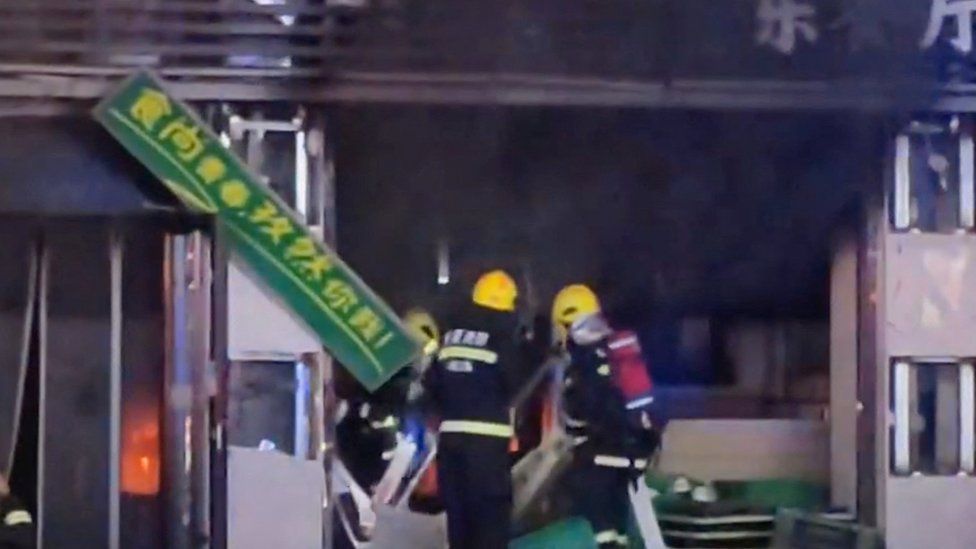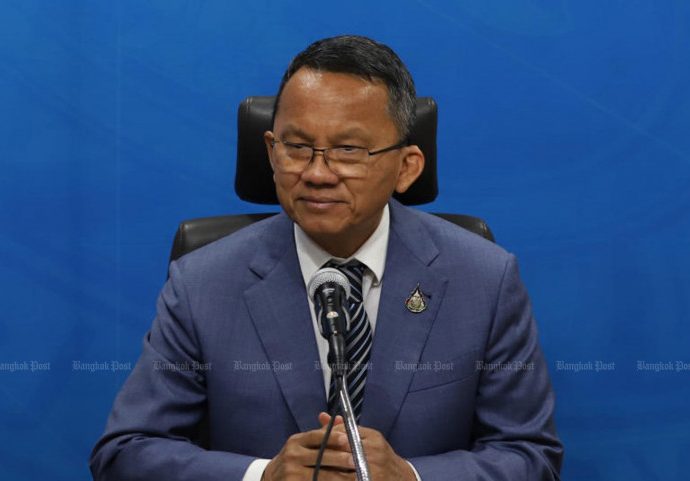One killed, five hurt in train-truck crash
Driver of Chiang Mai-bound train dies in collision with 18-wheeler in Nakhon Sawan
PUBLISHED : 20 Jan 2024 at 13:51

NAKHON SAWAN: The driver of a Chiang Mai-bound train was killed and five people were hurt when the train rammed into a trailer truck carrying a backhoe at a crossing in Chumsaeng district on Friday night.
The incident occurred at the Khlong Samphrueng railway crossing in tambon Phanlan, said police who were alerted about 7.30 pm on Friday.
According to police, rapid train No. 109 on the Krung Thep Aphiwat Central Terminal-Chiang Mai route left the terminal in Bangkok at 2.15pm on Friday. As it approached the crossing in Chumsaeng district, the 18-wheel trailer truck was driving into the crossing and into the path of the train.
The train driver was unable to apply the brakes in time, causing the train to hit the truck. The locomotive was badly damaged and the force of the crash caused the truck to overturn. The backhoe was thrown off the truck onto the tracks.
The train driver, identified as Pradit Phromma, was killed as his body was crushed by the locomotive. Five others, including four female train passengers and the trailer truck driver, were injured. All were taken to Chumsaeng Hospital where they were declared safe.
The crash disrupted train services on the northern route. Railway officials arranged buses to transfer train passengers. Rail services resumed at 7.15am on Saturday.
The State Railway of Thailand expressed regret over the incident and ordered an investigation.

A backhoe was thrown from a trailer truck onto the railway track following a crash on Friday night in Nakhon Sawan. (Photo: Chalit Phoomruang)
US laser weapon program hits a glaring blind spot – Asia Times
While broadly touted as the future of shipboard point and missile defense, laser weapons have been glaringly absent in the US-led coalition strikes against Iranian-supplied drones and missiles used by Houthi forces in Yemen to attack commercial vessels and warships in the Red Sea.
This month, Breaking Defense reported that Rear Admiral Fred Pyle, the US Navy’s director of surface warfare requirements, has expressed frustration with the current pace of laser weapon system development.
Pyle believes that the US Navy and American defense industry need to be more intellectually honest about what is possible with laser weapons, noting a tendency by both to overpromise and underdeliver.
Breaking Defense notes that the US Navy has sought to develop a capability that would enable a sailor underway to fire a laser that knocks down an enemy drone or takes out a small boat.
The report mentions Lockheed Martin’s experimental HELIOS laser aboard the USS Preble (DDG-88) as an example of a project that aims to bring the concept closer to real-world applications.
However, the source notes that Vice Admiral Brendan McLane, the US Navy’s top surface warfare officer, has expressed frustrations with the navy’s current pace of laser weapon system development, emphasizing that laser weapons must deliver on their promise of negligible cost per shot.
Pyle said that laser weapons need physical, weight, power and cooling space that may be unavailable to current US surface combatants. The report also quotes Secretary of the Navy Carlos Del Toro expressing concerns that laser weapon development has taken a long time to bear results.
While currently available US shipboard air defense weapons are effective, their high cost per shot and limited magazine depth raise significant cost and survivability concerns.
Lara Seligman and Matt Berg mention in a December 2023 Politico article that the US Navy has used Standard SM-2 missiles costing US$2.1 million in the Red Sea to destroy Houthi drones worth just $2,000, raising concerns about the cost-effectiveness and unsustainability of this kind of warfare.

Seligman and Berg note that while US destroyers can use their five-inch guns with airburst rounds for anti-drone defense, they can only hit targets ten nautical miles away, which may be dangerously close.
While they say that US destroyers can use Evolved Sea Sparrow Missiles to hit targets closer than five nautical miles, the missiles cost around US$1.8 million per shot.
Seligman and Berg point out that US destroyers’ last line of defense, the 20-millimeter Phalanx Close-in Weapons System (CIWS), can hit targets inside one nautical mile, but the closer the drone gets to the target, the higher the chances of a successful strike.
Given that high cost-per-shot ratio, the problems would undoubtedly be magnified if the US gets into a conflict with China over Taiwan, with China having much greater production capabilities and advanced drones and missiles than the Houthis in Yemen.
US laser weapon development is thus seemingly caught in limbo due to various unresolved practical and technological issues.
A December 2023 US Congressional Research Service (CRS) report notes that proponents of high-powered military lasers have made various predictions about when these weapons would be fielded that have repeatedly passed unrealized.
Laser weapon proponents cited by CRS say that the situation has changed due to advancements in solid-state laser (SSL) technology and the adoption of more realistic goals, including the use of kilowatt-power lasers for point defense instead of megawatt-power lasers for ballistic missile defense.
They say that skeptics may be prematurely abandoning the development of laser weapons due to past setbacks, despite steady and hopeful technological progress.
A separate August 2023 CRS report mentions that laser weapon development programs have been plagued by technological maturity issues related to improving beam quality and control, failure to deliver specialized facilities to maintain sensitive components and the lack of a defense industrial base to produce the weapons at economy of scale.
While the US Navy has positioned laser weapons on a few of its warships, it’s not clear if it has a strategic plan or timeline for widespread adoption of the technology.
Jared Keller notes in a January 2023 article for Task and Purpose that the US Navy has seven Optical Dazzling Interdictor Navy (ODIN) systems and one HELIOS laser.
Keller notes that while the navy is pushing to field laser weapons on surface warships as soon as possible it has at the same called for further at-sea testing of the HELIOS laser.
This month, Asia Times noted that the US Navy’s Arleigh Burke-class destroyers have already maxed out their upgrade potential, with internal space constraints limiting the installation of new power generation systems. That, in turn, means there is a lack of space for future sensors, communications and weapons systems.
Keller notes that Arleigh Burke Flight III destroyers may not be able to accommodate laser weapons, as most of its electric power is directed to its installed AN/SPY-6 Air and Missile Defense Radar (AMDR). That means the Arleigh Burke Mod 2.0 may be the platform of choice for laser weapons integration until the new DDG(X) design begins production in 2032.

Sebastien Roblin mentions in a Popular Mechanics article this month that the US Navy plans to upgrade 20 Arleigh Burke Flight IIA destroyers, which first entered service between 1998 and 2010, for US$850 million per ship, with each refit reportedly taking about 1.5 to 2 years.
However, Roblin points out that the Arleigh Burke Mod 2.0 upgrade program may suffer the same fate as the troubled attempts to upgrade aging Ticonderoga-class cruisers, where cost overruns and delays have hobbled full upgrades.
Roblin notes that as the US Navy has upgraded its Arleigh Burkes over the last four decades, the design is running out of free space for future upgrades including laser weapons.
China: 13 dead after school dormitory fire in Henan province
 Getty Images
Getty ImagesThirteen people have died after a fire broke out in a school dormitory in central China, the country’s Xinhua state news agency reported.
The deadly blaze happened on Friday night at a school for young children in Yanshanpu village, Henan province.
The privately-run school caters for nursery and primary age pupils, according to China Daily.
The manager of the school, near Nanyang city, has been detained and an investigation is under way.
One other person is being treated in hospital and is in a stable condition.
No further details about the identities of the dead or the cause of the fire were released via official channels. It was extinguished less than an hour after firefighters were alerted, Xinhua reported.
Fatal fires in China are not uncommon due to lax enforcement of building and safety standards.
In November, 26 people died after a large fire ripped through an office building in Luliang City, Shanxi province.
A hospital fire in Beijing last April claimed the lives of at least 29 people – mostly patients – and triggered an investigation which saw 12 people detained by police for questioning.
Harrowing footage of the fire showed people climbing out of windows onto air conditioning units to escape the flames.
-
-
22 June 2023

-
-
-
5 December 2022

-
Seoul police chief charged over deadly Halloween crush
SEOUL: Seoul’s chief of police has been charged with professional negligence over the deadly 2022 Halloween crush that killed nearly 160 people, prosecutors in the South Korean capital said. On Oct 29, 2022, tens of thousands of people – mostly in their 20s and 30s – had been out to enjoyContinue Reading
Gazans aren’t predestined to be eternal refugees – Asia Times
On September 9, 2023, less than a month before the October 7 massacre and the war that followed, violent clashes broke out between hundreds of young Gazans and security guards from a Gaza travel agency that had been granted a license to issue visas to Turkey. Several people were injured, and the company’s offices were damaged.
The Gaza branch of the Palestine Society of Tourism and Travel Agents (yes, Gaza did have a tourism and travel association) accused the travel agency of exploiting its monopoly on issuing permits to raise prices. So why did the fracas break out in the first place?
A study published by the Meir Amit Intelligence and Terrorism Center on migration from Gaza since the Hamas takeover in 2007 shows that some 300,000 young people have left the Strip in that time.
A report about a month before the war claimed that around 19,000 Gazans applied for a travel visa to Turkey within the space of just one week, and some 83,000 Gazans who had already applied for a visa were waiting to receive it.
Similar figures provided by human-rights organizations in Gaza were cited in the Arab press. The visa applicants seek to make it to Turkey and from there to Greece, elsewhere in Europe, and Canada.
According to reports, young people are driven to leave Gaza by a general sense of hopelessness: Hundreds of thousands of university graduates don’t have jobs; unemployment and poverty rates are increasing; the private sector is collapsing because of the destruction of enterprises and companies; the cost of living is soaring; there is insufficient social care and levels of service are low, especially in mental health and other fields.
Murderous theocracy
Life in the Gaza Strip was difficult before the war, and is even more so now, given the extent of the destruction. Hamas has established a theocracy in the Gaza Strip similar to Iran, which it serves.
This means a life without civil and human rights, without freedom of expression, without education; Gaza is ruled by a culture of death, and its subjects are destined from birth to serve as cannon fodder for the realization of its leaders’ sick lust for destruction.
The massive donations given to Gaza by European and American taxpayers were mostly stolen by senior Hamas figures, and the rest was used to build an underground city – a shelter for murderers – and to turn Gaza into a huge terrorist base whose residents were destined to serve as living shields.
There is no hope in Gaza. There probably never was. Even if we believe the delusions about Gaza’s reconstruction, it will take many years, and in the interim Gazans will live in tents as refugees. They will live in pitiful conditions and cultivate one aspiration – the destruction of the State of Israel (an aspiration that will inevitably lead to wars, which in turn will lead to further suffering and destruction, and more refugees).
Genocidal ideology
Hamas’ ideology is a direct offshoot of its parent movement, the Muslim Brotherhood. This ideology is clearly stated in the Hamas Charter that inspired the Hamas terrorists and their collaborators from among the “non-involved” Gazan population, to massacre us Israeli residents.
Two principles in the Charter constitute the raison d’être of its adherents: total commitment to the destruction of Israel and killing Jews wherever they may be.
It is no coincidence that Israeli soldiers found a translated Arabic copy of Mein Kampf in Gaza. For Hamas, Adolf Hitler is a role model. October 7 was a shocking demonstration of the genocide Hamas would inflict on us Israelis if it only could. The same spirit exists in the Palestinian Authority; the difference is in ability and opportunities.
Israel will fight to eliminate Hamas, but its totalitarian ideology will remain. It will ensure that Gazans will continue to be inculcated with a culture of death and destruction, lust for murder, and above all, a willingness to sacrifice themselves so long as they kill a small number of Jews.
Double standards
Given this state of affairs, is it not right for us to think seriously about helping Gazans emigrate so they will be able to start a new life, somewhere where children can go out in the morning to learn wisdom and science rather than death and the love of evil?
Tens of millions of refugees have moved to new places over the past hundred years and have rebuilt their lives. Why has Germany accepted a million refugees from Syria over the past decade without a veto from the West?
We have not heard anyone insist they return to Syria; indeed, we have not heard similar cries for the 11 million refugees displaced in that country. And what about the millions of Ukrainian refugees? These are just a couple of examples that illustrate the rule.
The United Nations has two refugee organizations, one for refugees from around the world, the United Nations High Commissioner for Refugees (UNHCR), and the other for the Palestinians, the Relief and Works Agency for Palestine Refugees in the Near East (UNRWA).
There are also different definitions of “who is a refugee.” The 1951 Refugee Convention, which defined the mandate of the UNHCR, stated that refugees are those who have been forced to flee their country because of political persecution or violation of their civil or political rights.
Later, the concept of a refugee was extended to those fleeing war and violence, and even economic persecution that makes it impossible to provide children with an education.
In contrast, UNRWA’s definition of a Palestinian refugee is someone whose “normal place of residence was Palestine during the period June 1, 1946, to May 15, 1948, and who lost both home and means of livelihood as a result of the 1948 conflict.”
Why is a stay of only two years sufficient to be considered a refugee? After all, the Palestinians claim to have lived here since time immemorial. This definition enabled, for example, a resident of Sudan who came here in 1943 to look for work and fled after the war, to receive the status of a Palestinian refugee.
In the rest of the world, refugee status ends once a refugee has been resettled; it certainly doesn’t pass on to future generations. But with Palestinian refugees under the care of UNRWA, things are different. They pass on refugee status to future generations, even those who settled in other countries and received citizenship. This is how we reached the absurd number of more than 5 million Palestinian refugees.
This has nothing to do with care and concern for Palestinian refugees; it stems from the desire to fuel the fires of hatred toward Israel and to keep alive the Palestinian dream of destroying Israel through what they call the “right of return” – in other words, flooding Israel with refugees so that it is no longer a majority Jewish state.
It is the United Nations that is responsible for this disgrace. UNRWA has not helped solve the refugee problem; it has perpetuated it, perpetuating hatred of Israel in the process. Why is the fate of the Palestinians better than that of the rest of the world’s refugees?
In 2014, when Islamic State (ISIS) tortured, murdered, and ethnically cleansed Yazidis in Iraq, and the world stood by, I saw a picture of a Yazidi woman holding a sign that read in English: “The problem of the Yazidi people is that our enemy is not Jewish.”
Two choices
The current Gaza war creates a historic opportunity to change the region and the fate of the refugees. Changing old concepts is not only about Israel’s security doctrine but also about the future of the region.
In the second half of the 19th century, the Jews of Eastern Europe lived in economic and social conditions similar to those the residents of Gaza live in today (the big difference was that they did not massacre their neighbors or dispatch terror and murder squads). As soon as the opportunity was afforded them, the Jews moved on to better places.
The prohibition on discussing voluntary migration of Gazans stems from the mistaken belief that this might sound like “ethnic cleansing.” It is not.
There are two alternatives for Gazans: a decent and dignified life, somewhere new, far from Hamas’ malign influence, or remaining in the Gaza Strip in pitiful conditions and with no hope.
We should not delude ourselves: Even if we build luxury neighborhoods for Gazans, life there will soon return to Third World conditions, because the Strip will continue to live under the ideology of death and destruction.
For now, hope for Gazans lies outside of Gaza.
13 dead in China school fire: State media
BEIJING: Thirteen people have died in a school dormitory fire in central China’s Henan province, the official Xinhua news agency reported Saturday (Jan 20). The blaze at the Yingcai School in Henan’s Yanshanpu village was reported to the local fire department at 11pm (1500 GMT) on Friday night, Xinhua said. ThirteenContinue Reading
It boils down to one question

A referendum question being discussed could prove costly both in monetary terms and for the reputation of Srettha Thavisin’s administration.
The warning comes from critics watching the charter amendment process unfold with caution and dread.
Half-hearted as the ruling Pheu Thai Party was thought to be in pursuing amendments, it has put Deputy Prime Minister Phumtham Wechayachai — an authoritative figure in Pheu Thai — in charge of the committee directing referendum business, a compulsory prelude to rectifying the constitution, as stipulated by the Constitutional Court.
The party, according to observers, would rather concentrate on jump-starting the sleepy economy than getting tangled up in changing the charter, which is a tedious and less politically rewarding affair.
However, its former pro-democracy ally, the main opposition Move Forward Party, has refused to let the amendment issue slip and its efforts to fix what it sees as a dictatorship legacy fall by the wayside. The charter was written and promulgated during the Prayut Chan-o-cha administration.
Unable to resist calls for an expedited charter rewrite, the Phumtham panel hit the ground running in the second half of last year by designing the charter amendment referendum.
It split members into groups, one of which went about gauging opinions from various professional, social and political sources on how the referendum should be conducted.
At the same time, how many referendums should be put to voters remains up in the air. One estimation is that three should be held to pave the way for charter revision.
When endorsed by the cabinet, the first referendum plan will be forwarded to the Election Commission (EC) for implementation in 90 to 120 days after that, Mr Phumtham said.
If the first referendum proves successful, the government will seek to amend Section 256 of the constitution to allow the formation of a new assembly, the composition of which will be decided in a joint sitting of the House of Representatives and the Senate, according to Mr Phumtham. Then there is the inevitable question as to how much the referenda will set the taxpayers back.
Senator Somchai Sawaengkarn, citing a study by a senatorial committee which compiled information from the EC and other agencies, said the three referenda will have a staggering price tag of 10.5 billion baht, or three times the expense of holding a general election.
There is also the election of the charter rewriting assembly, which is expected to cost five billion baht, as well as the salaries of its members totalling around 200 million baht per year.
But the critical point pertains to what the referendum question should be.
Mr Phumtham lost no time shedding light on this query. In fact, the referendum design committee chairman declared that only one question in the first of three referenda will be put to voters.
The question the Phumtham committee has in mind has to do with whether or not people agree with the proposal to amend the constitution, except for Chapters 1 and 2, which govern general provisions and the King’s prerogatives, respectively.
However, the proposed question immediately drew flak from critics, the most vocal of whom is Somchai Srisutthiyakorn, a former election commissioner, who insisted tiptoeing around certain chapters would mean a limited charter amendment, which would not necessitate a referendum in the first place.
Revising specific content of the constitution may be implemented by parliament without voters having to be consulted at all, as was the case with rewriting the clauses in the charter to revert the election system from the one-ballet method in the 2019 general election to two ballots in the previous poll in May last year.
Mr Somchai told a political talk show that the Phumtham committee’s question fails to specify the condition that the charter rewrite will be performed by an elected assembly. The absence of such a stipulation could give the government a free hand in extending assembly membership to people with political affiliations, which could create a biased charter.
Senator Somchai, meanwhile, warned the government that in formulating the referendum question, it must also look beyond Chapter 2 and steer well clear of sections where content related to the King’s prerogatives also exist. The government has not mentioned anything about such content being off-limits for change.
Observers said the senator’s warning could give royalist yellow shirts a reason to justify criticising the government for not being “thorough” enough and letting essential details slip through its fingers.
Its own worst enemy
The Move Forward Party (MFP) may have bounced back as an opposition force to some degree, but it is still reeling from internal controversies.
The party has announced that the opposition is seriously thinking about initiating either a no-confidence debate or a general debate against the government around the end of March or early April.
Admired for its tenacity in looking into allegations against and exposing policy blunders by the previous and current administrations, the MFP has been accused by opponents of using the debate plan to draw public attention away from a series of sexual abuse and misconduct scandals involving its members and MPs.
Supporters insisted the MFP has found its feet again as they are strongly convinced the New Year has ushered in a new and brighter chapter for the party.
This week, Parit Wacharasindhu, a Move Forward Party list-MP and party spokesman, said the time to grill cabinet ministers, who took office in late August last year, was fast approaching.

Parit: ‘Less than forthright’
Srettha Thavisin’s administration had a taste of things to come shortly after the New Year break when the opposition went after the government over its budget expenditure plan in parliament.
Some academics gave the MFP the thumbs-up for its debate performance, having been won over by the party’s ability to crunch numbers and give a thorough review of funds to be allocated to ministries with the aid of technological tools for analysis, which pointed to flaws in how the budget was prepared and to be distributed.
Budget scrutiny by the opposition, which also includes the Democrat Party, may provide a sneak preview of something much more substantive and damning to the government, according to a source.
The source said the MFP has a lot of weighing up to do in deciding to initiate a no-confidence or general debate.
However, a general debate has little teeth since no censure vote is cast, whereas a no-confidence session has a chance of sinking the government.
According to Mr Parit, the MFP is zeroing in on where it will try and hurt the administration the most — the highly controversial digital wallet scheme and flagship election promise of the ruling Pheu Thai Party, as well as the 1-trillion-baht Land Bridge megaproject, which some experts believe is not attracting prospective investors overseas.
They say the project’s viability is left wanting by the short distance supposedly saved for cargo ships currently going around the Strait of Malacca.
The wallet scheme has been criticised for having been modified so much that it has veered from its original goal of causing a so-called economic “tsunami” essential for jolting the economy back into life.
The source said the MFP will never be short of material to launch a no-confidence attack on the government over the digital wallet handout and Land Bridge project.
The source thought Mr Parit was less than forthright when asked if the MFP was sliding away from the issue of jailed former premier Thaksin Shinawatra’s extended stay in hospital and not being in prison where he is supposed to be serving a sentence. Thaksin is believed to command significant influence over the ruling Pheu Thai Party.
Mr Parit said the MFP regards every censure issue it picks as equally important for maintaining accountability. The party places a particular focus on the digital wallet scheme on account of it requiring a huge 500-billion-baht loan to finance, which, therefore, entails a large economic impact. But just as the MFP was looking to make strides in this vein, it was hit yet by a fresh scandal, this time involving a serious assault on a party specialist by fellow members during a New Year and Children’s Day celebration in Nonthaburi.
Mr Parit said the party was not taking the issue lightly and reiterated the MFP’s zero tolerance for all forms of violence.
It was reported the specialist wants to contest a local election in an area dominated by a party MP whose aides carried out the assault. The specialist was left in a serious condition after the attack, and he subsequently filed a police complaint against his attackers.
Apocalypse too soon – Asia Times
Customer help desks are a top target of money-saving schemes involving generative AI, as I reported earlier in an attempted takedown of the chatbot. Now I’m convinced that automating customer service will bring the apocalypse somewhat nearer, not because machines will become sentient, but because the machines turn perfectly normal human beings into morons.
It started when a family member included in my T-Mobile plan lost a handset. It happens.
Each month I fork over $18 to T-Mobile’s partner Assurant for handset protection, so I clicked on Assurant’s website to file a claim. But the website went into an infinite loop: To file a claim, the site demanded a one-time password sent to the handset in question, which is the handset that was lost, and therefore couldn’t receive a one-time password or anything else.
Use another handset from the same account to get the oneoo-time passwor, Assurant’s convenient pop-chat function told me. I should have known better. ChatBots make things up, as a couple of New York lawyers discovered when their AI-generated legal brief presented cases that didn’t exist. The same thing can happen with help desks.
Stupidly, I did as instructed. But Assurant’s system assumed that the lost handset needing tobe replaced was the one that had received the one-time password, namely my own handset. After I forked over a $250 deductible, Assurant promptly sent out a replacement for my handset, a venerable Samsung device that had worked uncomplainingly for years and remained comfortably nestled in my shirt pocket.
Once I was in receipt of the wrong replacement handset, I called Assurant customer service and explained the error (it was Assurant’s error, not mine). I returned the handset with the next UPS pickup. Assurant apologized for the error, and took a second $250 deductible to replace the handset that actually had been lost, promising to refund my first $250 deductible when the first replacement handset arrived.
In due course, the correct replacement handset arrived, and all seemed well, except for the deductibles, of course.
But I was unaware that the unquiet spirit of Franz Kafka had quietly possessed the soul of T-Mobile and Assurant customer service.
My handset stopped connecting to the network in the middle of a weekday afternoon, ten days after my initial encounter with the Catch-22 on Assurant’s website. I was traveling and between meetings. I had a backup phone (I’m the sort of Airport Dad who always has a backup) and I spent two hours on the line with T-Mobile customer service until someone figured out that Assurant, not T-Mobile, had blocked the SIM card on my handset, because it had been reported lost.
It never was reported lost – its only offense was to receive a one-time password – and Assurant customer service had known of its error for ten days. But the misinformation had worked its way through the system over those days.
At length I talked to someone at Assurant, who said that it would take one business day, or maybe one to three business days, to unblock my SIM card. I begged, cajoled and threatened the Assurant tech as well as her supervisor, to no avail. The phone still isn’t working.
Fortunately, most of my friends have stopped using cell phone connections in favor of encrypted messaging apps, and these apps run on WiFi. I can turn on the data hotspot on my backup phone and use the messaging apps on my handset with the still-blocked SIM Card.
A supervisor finally took my call at T-Mobile. I asked her if I could record the call (which T-Mobile says it does whenever you call them). She hung up. Her AI system probably flashed, “Abort! Abort!”
If you’ve been trying to call me on my regular line, and I haven’t answered, now you know why.
T-Mobile, Verizon and AT&T cost a lot more than the discounters. What you pay for is superior customer service, which means a lot in an emergency. But as AI systems metastasize through customer service departments, the advantage disappears. If you’re going to be mistreated by a machine, might as well pay less for the privilege.
Power of Siberia 2 stuck on gas price, branch issues – Asia Times
Beijing has kept progress of the discussion about building a new gas pipeline from Russia to China slow, as issues such as the gas price, a proposed new branch and a potential partnership in downstream businesses still linger.
The feasibility study of the “Power of Siberia 2” project, designed to deliver 50 billion cubic meters (bcm) of natural gas from Russia to China annually, was approved by Russia’s Gazprom in 2021. Both sides reportedly achieved a consensus in principle last month.
While Moscow hopes to close the deal in the first quarter of this year, Beijing has so far adopted a wait-and-see approach in order to increase its bargaining chips at the negotiation table.
Chinese commentators say China wants the Russian side to “show more sincerity.” They add that Russia needs money to fund its battles in Ukraine – but China is not in a hurry to strike a deal; it has other options to diversify its energy supply.
“Although heads of the Chinese and Russian governments met in Beijing in December and discussed how to push forward an agreement for the Power of Siberia 2, it’s not easy to implement what was discussed,” a Shanxi-based columnist using the pen name of “Song Jun“ writes in an article published earlier this month.
“The two sides reached a consensus in principle but they still need to discuss the gas prices, delivery and payment methods,” he says. “Before signing a contract, they will have to resolve a lot of operational problems and find solutions to fulfill their own needs, market positions and economic benefits.”
”Although Russia urgently needs money and has a good relationship with China, Beijing will not allow the Russian side to set the gas price freely,” Jiang Fuwei, a Hainan-based columnist, says in an article.
“China and Russia will eventually make agreements on all the operational issues such as gas price and payment method. The question is which side will compromise,” Jiang says. “For this matter, China has an advantage.”
He says Russian oil and gas supply is very important to China’s energy security as the Chinese maritime routes are facing some external threats. However, he adds that China will not put all its eggs in one basket.
He says China has already been importing gas from Turkmenistan and is seeking to get fossil fuels from the Gulf through a new trade route passing through Pakistan.
He says the fact that Russian President Vladimir Putin held a meeting with Gazprom Chief Executive Alexey Miller on December 26, lasting until 2 am, showed that the Russian side could not wait any more. He says it’s still possible that China and Russia can sign a sale agreement in Spring 2024.

“Over the past two months, the Russian side has reported three times that the existing Power of Siberia’s daily gas supply recorded high,” an associate professor at the Sichuan University using the pen name “Qianli Ke” writes in an article published on December 25. “Russians closely monitor the figures and treat them as news because they want to push forward the Power of Siberia 2 project.”
“Someone said the matter is not only about gas price but may be related to Mongolia. As far as I know, Russia wants the pipeline to pass through Mongolia but China has concerns,” he says.
“Putin should understand that no matter how good Sino-Russia relations are, he must show more sincerity,” he says. “Otherwise, there is no other way to move forward.”
A new branch
In December 2019, Russia started supplying natural gas to China’s northeastern region through the original 3,000 kilometer Power of Siberia gas pipeline, which can deliver 38 billion cubic meters of gas to China annually.
China and Russia then started discussing the 2,800 km Power of Siberia 2 project, which was set to begin construction in 2024 and be completed in 2029.
Beijing wanted the gas to be sent directly from Russia to northwest China’s Xinjiang province but Moscow said building such a pipeline, which passes through the hilly areas of its Tuva Republic region, is more expensive than having a route via Mongolia.
Despite Beijing’s concerns that Mongolia may lean towards the United States one day, Russia kept pushing for a pipeline that passes through the landlocked nation, which was a part of the Qing empire before 1911.
After Mongolia signed an “open skies” agreement and proposed a rare-earth partnership with the US last August, China suggested that Russia build an extra branch for the Power of Siberia 2.
The Russian side seemed to have listened to Beijing’s request. On September 6, Russian Deputy Prime Minister Alexander Novak wrote in an article for the Energy Policy magazine that a 700-kilometer-long branch from Naushki to Ulan-Ude and then to Chita is under review.
He said the main pipeline will pass near cities of Achinsk, Krasnoyarsk, Kansk, Sayansk, Angarsk and Irkutsk and then over the territory of the Republic of Buryatia (to the south of Lake Baikal) until reaching the Russian-Mongolia border in the vicinity of Naushki settlement.

“The establishment of a branch was suggested by the Chinese side,” a Shandong-based writer says in an article published last September. “Firstly, it can save costs. Secondly, it can ease security concerns. A pipeline passing through Mongolia really makes China feel not so reassured.”
“After reaching Chita, the gas supply can directly enter China without passing through Mongolia. And there is a railway connecting Chita and China’s Manzhouli,” he says.
“At present, Russia’s special military operations in Ukraine are ongoing and spending a huge amount of resources and money on a daily basis,” he says. “It is urgent for Russia to close its natural gas deal with China as soon as possible to ensure a stable income.”
A Zhejiang-based commentator called “Guoba Ge” says the branch will reach Hulin in China’s Heilongjiang province. But he does not elaborate.
Downstream businesses
When Putin and Chinese President Xi Jinping met in Beijing on October 19, they discussed the Power of Siberia 2 but did not sign any agreement. Both sides said they wanted to achieve some real progress.
On December 19, Zhang Hanhui, Chinese Ambassador to Russia, told Russian news outlet RT that companies from both sides are actively negotiating technical, business and cooperation issues for the Power of Siberia 2 and need thorough justification, scientific and systematic, in order to implement the megaproject.
“China consistently advocates an upstream-and-downstream-integrated approach for the Power of Siberia 2 project,” he said. “This is due to the desire not only to extend cooperation from trade to the entire production chain, but also to build a more long-term and sustainable model of cooperation with Russia.”
Zhang’s comments were followed by a meeting between Russian Prime Minister Mikhail Mishustin and Xi in Beijing on December 20 and another between Putin and Miller in St. Petersburg on December 26.

Russian Deputy Prime Minister Alexander Novak said on December 27 that Gazprom and China National Petroleum Corporation (CNPC) reached an agreement in principle to implement the project and were finalizing the commercial terms, including the gas price, terms of supplies and payment methods. Beijing has so far remained tight-lipped about the negotiation.
Russia is now selling its natural gas to China for US$271.6 per thousand cubic meters and to Europe and Turkey for US$481.7.
Read: US-Mongolia aviation pact as a rare earths hedge
Follow Jeff Pao on Twitter at @jeffpao3
Fireworks factory rules to be revised
PUBLISHED : 20 Jan 2024 at 06:03

Deputy Prime Minister Somsak Thepsutin has told five ministries to revise their rules for controlling fireworks factories in the wake of an explosion at a Suphan Buri factory that killed 23 people on Wednesday.
Mr Somsak held a press conference on Friday at Government House alongside the permanent secretary of the Ministry of Industry, Nattapol Rangsitpol, and the deputy director-general of the Department of Provincial Administration, Somchai Lersprasittipan following a meeting about compensation for the Suphan Buri explosion.
The meeting also looked at developing further regulatory guidelines for fireworks sales and production.
Mr Somsak said regulations for fireworks factories fall under the responsibility of five ministries — the Ministry of Defense, Ministry of Interior, Ministry of Public Health, Ministry of Labour and Ministry of Industry — and they should all be revised.
As part of that, he said the Ministry of Industry had been told to draft a bill to better regulate small-scale fireworks factories that employ less than 50 people.
The ministry is required to report back to Mr Somsak within 10 days, with the report to be later submitted to Prime Minister Srettha Thavisin for consideration.
The meeting also wanted to include a regulation that fireworks factories must provide their workers with life insurance.
The matter will be later discussed between the Ministry of Labour and the Ministry of Commerce, he said.
Mr Nattapol, the Permanent Secretary of the Ministry of Industry, proposed that fireworks factories have separate locations for production and storage out of safety concerns.
Regarding compensation for 17 families who lost their loved ones in the Suphan Buri explosion, Mr Somsak said it would be offered to them after the victims’ death certificates were issued.










